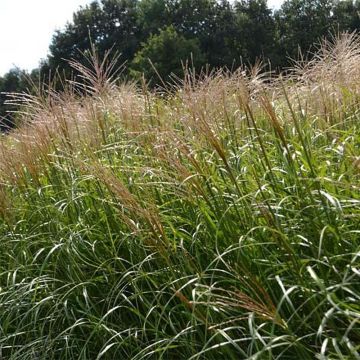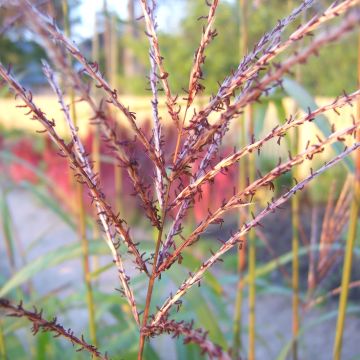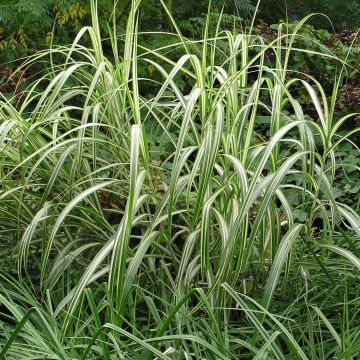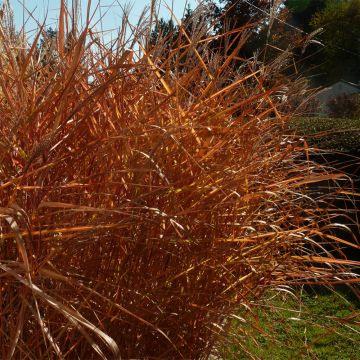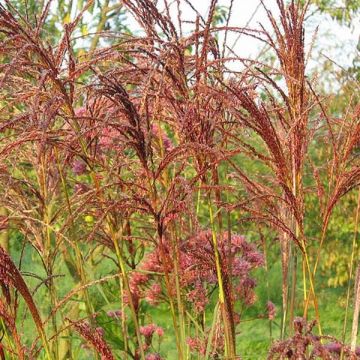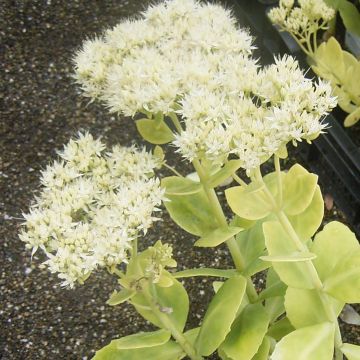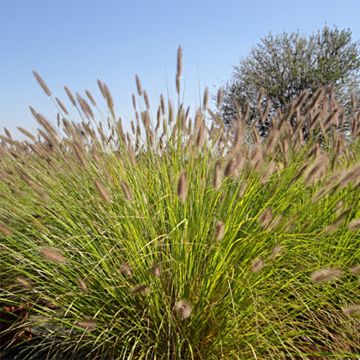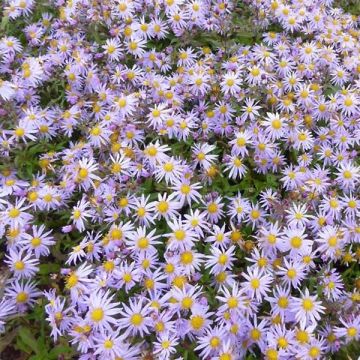

Miscanthus sinensis Ghana - Silvergrass
Miscanthus sinensis Ghana - Silvergrass
Miscanthus sinensis Ghana
Eulalia, Porcupine Grass, Chinese silver Grass, Maiden Grass, Zebra Grass, Susuki Grass
Small plant not very pretty. I hope it's normal considering the season and that it will recover and grow.
Zoé , 19/11/2020
Why not try an alternative variety in stock?
View all →This plant carries a 12 months recovery warranty
More information
We guarantee the quality of our plants for a full growing cycle, and will replace at our expense any plant that fails to recover under normal climatic and planting conditions.
From €5.90 for pickup delivery and €6.90 for home delivery
Express home delivery from €8.90.
From €5.90 for pickup delivery and €6.90 for home delivery
Express home delivery from €8.90.

Does this plant fit my garden?
Set up your Plantfit profile →
Description
Miscanthus sinensis 'Ghana' is a splendour in autumn. This Chinese reed with an upright habit truly stands out in borders with its remarkable foliage, where shades of fawn, purple, chocolate, and reddish-orange, all compete for brilliance on leaves that are supple and silky like ribbons. Far from being left out, its late summer flowering bursts into narrow, feathery panicles in a purplish to reddish hue, then gently fades to a bronzish silver. It is a sumptuous perennial grass with a slightly spreading stump, growing slowly but surely. It remains decorative until the heart of winter when its plumes are finely powdered with frost.
The 'Ghana' eulalia belongs to the Poaceae family. It is a horticultural form derived from Miscanthus sinensis, native to China (in the pan-Himalayan region up to 2000m (6562ft) altitude), Korea, Japan, Taiwan, Malaysia, and New Zealand. This perennial and clump-forming grass, with short rootstocks, forms a fairly narrow tuft with an upright and trailing habit, reaching a height of 1.2 to 1.4m (4 to 5ft), with a spread of 70 to 80cm (28 to 32in). This plant has marcescent foliage, meaning that it remains attached to the stump, although lifeless. The leaves are thin, very long, and flexible. They are initially light green in colour, then multicoloured in autumn. Long floral stems emerge from the foliage from August to October and persist until November-December. The flowering takes the form of silky digitate spikes, 20 to 30cm (8 to 12in) long, in deep rose-red to silvery hues. When wilting, they take on a brushed silver-brown colour. The plumes are made up of tiny flowers that close slightly after opening, only to open again when mature. They then take on a paler and more feathery appearance.
This highly colourful eulalia has deciduous foliage but remains decorative for much of the winter. It is ideal for large borders, to which its strong presence brings structure and grace. It is also suitable for wild gardens and contemplative gardeners. Just plant it among asters, behind garden chrysanthemums, or perpetual roses. Watch it grow and expand, play with the wind and the low autumn light, and bend under rain showers. In winter, it lights up the garden with its reassuring silhouette. It has its place in modern gardens with clean lines, accompanied by bamboo or ferns if the soil is moist. Miscanthus is well suited for hedge planting, providing a screen along a path, isolating a part of the garden, or simply hiding the view of the street or a neighbour's garden. In this usage, they offer a somewhat surreal walk in the midst of vegetation. These grasses bring volume and texture to the boundaries of the garden, creating a natural transition to open areas. In an urban garden, Miscanthus 'Ghana' softens concrete structures. Cultivation in large containers is also possible. It is perfect for dried bouquets.
Some varieties of miscanthus are currently being studied, as they offer real prospects for the creation of standing crop or fibre panels. These plants have several advantages: they do not deplete the soil, tolerate polluted soils well, and can be incinerated or even used to produce biofuel.
Report an error about the product description
Miscanthus sinensis Ghana - Silvergrass in pictures




Flowering
Foliage
Plant habit
Botanical data
Miscanthus
sinensis
Ghana
Poaceae
Eulalia, Porcupine Grass, Chinese silver Grass, Maiden Grass, Zebra Grass, Susuki Grass
Cultivar or hybrid
Other Miscanthus
Planting and care
Miscanthus sinensis 'Ghana' thrives in warm exposures and healthy, fairly rich, deep soil that is well-drained but remains moist in summer. This plant tolerates occasional drought if planted in deep soil. It can adapt to poor soil, but it will be less imposing and its growth will be slower. It is best to cut back the foliage to ground level at the very beginning of spring, after the strongest frosts have passed. For container planting, choose a large pot (minimum 45L) filled with a fertile, well-draining and flexible growing medium. A mixture consisting of 20% good garden soil, 20% drainage elements (such as pumice or gravel or coarse river sand), and 60% horticultural compost is ideal. Apply well-decomposed compost once or twice a year (end of winter and autumn) or slow-release fertiliser. When it becomes less floriferous, divide the clump and replant the peripheral shoots. This plant requires space to establish itself and does not appreciate root competition.
Planting period
Intended location
Care
-
, onOrder confirmed
Reply from on Promesse de fleurs
Late flowering perennials
Haven't found what you were looking for?
Hardiness is the lowest winter temperature a plant can endure without suffering serious damage or even dying. However, hardiness is affected by location (a sheltered area, such as a patio), protection (winter cover) and soil type (hardiness is improved by well-drained soil).

Photo Sharing Terms & Conditions
In order to encourage gardeners to interact and share their experiences, Promesse de fleurs offers various media enabling content to be uploaded onto its Site - in particular via the ‘Photo sharing’ module.
The User agrees to refrain from:
- Posting any content that is illegal, prejudicial, insulting, racist, inciteful to hatred, revisionist, contrary to public decency, that infringes on privacy or on the privacy rights of third parties, in particular the publicity rights of persons and goods, intellectual property rights, or the right to privacy.
- Submitting content on behalf of a third party;
- Impersonate the identity of a third party and/or publish any personal information about a third party;
In general, the User undertakes to refrain from any unethical behaviour.
All Content (in particular text, comments, files, images, photos, videos, creative works, etc.), which may be subject to property or intellectual property rights, image or other private rights, shall remain the property of the User, subject to the limited rights granted by the terms of the licence granted by Promesse de fleurs as stated below. Users are at liberty to publish or not to publish such Content on the Site, notably via the ‘Photo Sharing’ facility, and accept that this Content shall be made public and freely accessible, notably on the Internet.
Users further acknowledge, undertake to have ,and guarantee that they hold all necessary rights and permissions to publish such material on the Site, in particular with regard to the legislation in force pertaining to any privacy, property, intellectual property, image, or contractual rights, or rights of any other nature. By publishing such Content on the Site, Users acknowledge accepting full liability as publishers of the Content within the meaning of the law, and grant Promesse de fleurs, free of charge, an inclusive, worldwide licence for the said Content for the entire duration of its publication, including all reproduction, representation, up/downloading, displaying, performing, transmission, and storage rights.
Users also grant permission for their name to be linked to the Content and accept that this link may not always be made available.
By engaging in posting material, Users consent to their Content becoming automatically accessible on the Internet, in particular on other sites and/or blogs and/or web pages of the Promesse de fleurs site, including in particular social pages and the Promesse de fleurs catalogue.
Users may secure the removal of entrusted content free of charge by issuing a simple request via our contact form.
The flowering period indicated on our website applies to countries and regions located in USDA zone 8 (France, the United Kingdom, Ireland, the Netherlands, etc.)
It will vary according to where you live:
- In zones 9 to 10 (Italy, Spain, Greece, etc.), flowering will occur about 2 to 4 weeks earlier.
- In zones 6 to 7 (Germany, Poland, Slovenia, and lower mountainous regions), flowering will be delayed by 2 to 3 weeks.
- In zone 5 (Central Europe, Scandinavia), blooming will be delayed by 3 to 5 weeks.
In temperate climates, pruning of spring-flowering shrubs (forsythia, spireas, etc.) should be done just after flowering.
Pruning of summer-flowering shrubs (Indian Lilac, Perovskia, etc.) can be done in winter or spring.
In cold regions as well as with frost-sensitive plants, avoid pruning too early when severe frosts may still occur.
The planting period indicated on our website applies to countries and regions located in USDA zone 8 (France, United Kingdom, Ireland, Netherlands).
It will vary according to where you live:
- In Mediterranean zones (Marseille, Madrid, Milan, etc.), autumn and winter are the best planting periods.
- In continental zones (Strasbourg, Munich, Vienna, etc.), delay planting by 2 to 3 weeks in spring and bring it forward by 2 to 4 weeks in autumn.
- In mountainous regions (the Alps, Pyrenees, Carpathians, etc.), it is best to plant in late spring (May-June) or late summer (August-September).
The harvesting period indicated on our website applies to countries and regions in USDA zone 8 (France, England, Ireland, the Netherlands).
In colder areas (Scandinavia, Poland, Austria...) fruit and vegetable harvests are likely to be delayed by 3-4 weeks.
In warmer areas (Italy, Spain, Greece, etc.), harvesting will probably take place earlier, depending on weather conditions.
The sowing periods indicated on our website apply to countries and regions within USDA Zone 8 (France, UK, Ireland, Netherlands).
In colder areas (Scandinavia, Poland, Austria...), delay any outdoor sowing by 3-4 weeks, or sow under glass.
In warmer climes (Italy, Spain, Greece, etc.), bring outdoor sowing forward by a few weeks.








































